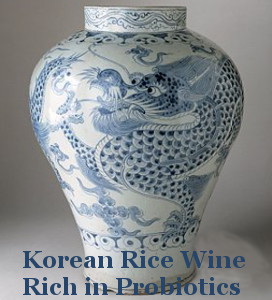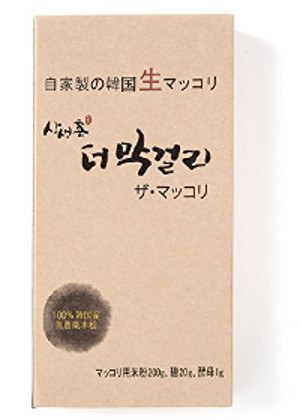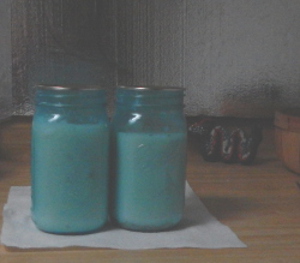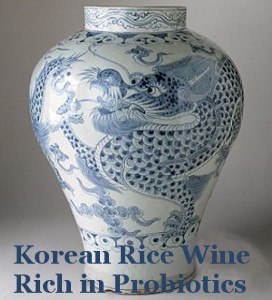 11/27/2016 ~ I have a Korean friend on Twitter who mentioned making and drinking Makgeolli, a Korean wine. He talked about adding leaves and things from his garden.
11/27/2016 ~ I have a Korean friend on Twitter who mentioned making and drinking Makgeolli, a Korean wine. He talked about adding leaves and things from his garden.
He said that the wine is loaded with good bacteria and therefore is very healthy to drink. When I looked up Makgeolli, articles said that it has a much higher good bacteria content than yogurt. I was immediately super interested. I don’t make yogurt as much as I ought to because I tend to eat the whole batch in a day, and while that’s great for killing h.pylori, it’s also great for weight gain.
I’m delighted that the option to make Mageolli has presented itself. You see, I can’t afford to keep Grand Marnier in the house, just as I can’t afford to order wine online. Being housebound it’s wonderful to have the option to make Makgeolli. I’m really hoping this works well and tastes lovely.
 Having looked at the three kits offered on Amazon, I opted for the smallest. While the largest seemed like a good idea because it came with an appropriate jar for making the wine, I felt as if a gallon would be hard to work with given that I can’t stand up.
Having looked at the three kits offered on Amazon, I opted for the smallest. While the largest seemed like a good idea because it came with an appropriate jar for making the wine, I felt as if a gallon would be hard to work with given that I can’t stand up.
Since I had no liter jars, likely because we didn’t elect Lincoln Chaffee who was running on a campaign platform devoted to bringing the United States onto the metric standard, 😉 I ordered wide mouth, quart Mason jars that came in sets of four. And, not quite understanding how the fermenting would work, I ordered some Easy Fermenter air lock covers for the Mason jars, the reviews for which were stellar.
The kit, Mason jars and air lock covers arrived in Prime speed. The kit contained a packet of organic Korean rice flour, and two smaller packets that were labeled in Korean with no translation. Thus, I began to wonder what you need to make Korean wine, besides rice flour and yeast. What, I wondered, was in the smallest packet.
After watching several videos and reading several accounts of making rice wine, I set about using my Makgeolli kit today.
To be sure I had the directions, which are available on Amazon and are not included in the kit, I put them into a Word document, printed them and took them into the kitchen with me.
How to make Korean Makgeolli
1. Pour 1 liter of water in a container. Add leaven and yeast and mix well until all leaven has melted.
2. Add 7 oz. (200g) of rice flour and stir well with a whisk or hand mixer until there are no lumps.
3. Close the container and let it sit at a room temperature for 3-4 days. Stir it twice a day, morning and evening.
4. After 3-4 days of fermentation, the mixture will form separate layers. Strain liquor through a sieve to sift out the leaven.
5. Keep the liquor in the refrigerator. (Keep the lid loose to prevent further fermentation.)
6. Enjoy home-brewed makgeolli to your own preference by adding honey, sugar, fruit juice or fruit syrup.
I read the directions several times, washed a Mason jar, Easy Fermenter lid and my hands several times, and poured water into the jar, nearly to the top to be as close to a liter as possible. When I added the rice flour, it was clear that I should not have filled the jar so full of water. There was nothing to do but wash another Mason jar and put half the water and rice into it.
Yes, you may have caught that despite reading the directions repeatedly, I started out wrong. I added the rice flour to the water first, when I was supposed to add the yeast and the other packet and then stir till the yeast was “melted.”
Not only that, I wanted to compensate for how cold my house is, so I’d added some heated water to the filtered tap water. The result may have been that the sticky rice flour sort of cooked and thus became even more sticky. It’s consistency was rather close to a pudding thickness.
Still, I forged ahead and added the contents of the yeast packet and the contents of the very small packet.
The yeast looked as if it were a Yeast Ball that had been broken up into smallish pieces. I had discovered that Amazon sells Yeast Balls, used in making Rice Wine. I was, however, unable to discover whether the Yeast Balls contain some of the mold or fungus or whatever it is that the kit called “Leaven”.
I began mixing the yeast into the rice flour water and soon realized it was going to take a very long time to mix the lumps into non-existence.
 I found my as yet never used whisk for my hand held blender, washed it and set about whisking the two Mason jars of somewhat evenly divided Korean Wine making ingredients. The yeast resisted “melting”. I decided that I would let it rest and that later this evening when I stir it with the electric whisk it will likely be more amenable to melting, for having become saturated.
I found my as yet never used whisk for my hand held blender, washed it and set about whisking the two Mason jars of somewhat evenly divided Korean Wine making ingredients. The yeast resisted “melting”. I decided that I would let it rest and that later this evening when I stir it with the electric whisk it will likely be more amenable to melting, for having become saturated.
So, there we have it. And, I must say, I’m Stoked.
Here’s my favorite video on making Korean Rice Wine. It’s long, but the fellow is quite good, though he adds the one thing so quickly I can’t quite catch what it is. I think it must be equal to whatever is in the tiny packet in the Kit.
11/29/2016 ~ I’ve been worried that my rice wine won’t properly ferment because of how cold my home is, given that I heat with candles. But, today when I was doing my morning stir, there was a pleasant alcohol fragrance, a very light fragrance, but a fragrance none-the-less.
Candle Heating ~ Read more.
11/30/2016 ~ I’ve had a trying day. So, I was almost afraid to have a glass of my freshly brewed Korean Rice Wine. Almost. But, in the end I thought that if it were good, it could vastly improve my day. So, I poured myself a glass of the Makgeolli with freeze dried strawberries.
 Mother Earth Freeze Dried Strawberries
Mother Earth Freeze Dried Strawberries
It is so Good! It is completely wonderful. It’s delightfully fizzy, like a wine spritzer. I really had no idea it would be this good. I’m totally Stoked.
In fact, I’m so stoked I ordered some freeze dried blackberries for my next batch of Mageolli. The only thing I’m not clear on, is if Chinese yeast balls will produce the same healthy bacteria wine as the Korean kit I used. I ordered the yeast balls because they come with the mold… or, some mold. I’m not sure if Korean rice wine has a different mold/fungus than Chinese or Japanese rice wine.
I was going to order a Sake set so I could heat my rice wine. It seems like it would be fun to have a warm, tiny little cup of wine on a cold day. But, on the other hand, this glass of Makgeolli is totally superb, and my spirits are warmed, if not my hands. I think I better try the rice wine without strawberries, just to compare. … *wink

12/1/2016 ~ Today is the fourth day of fermenting my Korean Rice Wine. I’m having a glass now, and it’s much less fizzy than yesterday, and actually, a better flavor. It tastes a little more wine like, and less like it’s in the process of fermenting.
Yesterday when the wine with strawberries was better than that without, I added strawberries to the “without” jar.
The wine looks like milky tea. That’s after I stirred it and poured myself a glass. Before that it was beginning to separate into a clearer liquid at the top, and a more milky liquid at the bottom.
Broken Wall Blue Sky 3D Removable Wall Art ![]()
I’m very curious to see if I can ferment more Korean wine by adding some that I’ve already made to a jar with filtered water and sweet rice flour.
My jars are 32 ounces, which is slightly smaller than the liter jars called for in the Korean Rice Wine Kit. So, I used 2/3rds of a cup of Sweet Rice Flour, and filled the jar about 2/3rds full of liquid, so there would be room to whisk the fermenting wine, morning and evening, without it spilling over the top. I forgot to put in freeze dried strawberries, but I can do that later.
So far, this is a very happy making project.
Does Korean Rice Wine have healthy probiotics?
Before I tasted my Makgeolli, I was willing to believe it offered healthy probiotics. But, then when it tasted so good, and alcoholic like wine, I encountered some doubts.
Upon doing some research it turns out that YES, Makgeolli provides healthy probiotics:
Makgeolli, a traditional Korean alcoholic beverage, includes many kinds of lactic acid bacteria (LAB). In this study, 17 different LAB strains were isolated from makgeolli and their functional effects were examined. The 17 LAB were identified as eight Pediococcus acidilactici strains, six P. pentosaceus strains, two Lactobacillus curvatus strains, and one L. curstorum strain. Evaluation of nitric oxide (NO) production showed that all of the LAB strains except P. acidilactici 4 (PA4) produced higher amounts of NO than L. rhamnosus GG, indicating that they may have immunomodulatory effects. In addition, P. acidilactici 5 ( PA5), P. pentosaceus 5 (PP5), L. curvatus 1, and L. curstorum 1 exhibited high acid tolerance properties. PA5 and PP5 also exhibited good bile acid tolerance. Lastly, Caco-2 cell adhesion experiments revealed that PA5 had a high cell adhesion rate of 19-43%. In conclusion, PA5 may be useful as a probiotic for further food industry applications. Probiotic properties of lactic acid bacteria isolated from Korean rice wine Makgeolli, Park, YU., Kim, MD., Jung, DH. et al. Food Sci Biotechnol (2015) 24: 1761.
I wasn’t sure what “immunomodulatory effects” meant, so I googled L.rhamnosus GG and discovered that in a study of 594 children, those drinking milk with L.rhamnosus GG had a lower incidence of tooth decay. Effect of Long–Term Consumption of a Probiotic Bacterium, Lactobacillus rhamnosus GG, in Milk on Dental Caries and Caries Risk in Children, University of Helsinki, 2001. Read more.
12/2/2016 ~ My nearly finished Korean Rice Wine has been sitting on a counter in the cooler part of my kitchen, maybe 58*. I’m not sure. Anyway, I’m having a glass and it is so good. It’s much more refined tasting than on earlier days. It’s like a light, white grape wine, only I think I like it better. And, that’s not even because of the good bacteria in it.
I didn’t finish doing research yesterday because it became complicated to explain how bad gut bacteria seems to be linked to chronic heart failure, read more, and how the good bacteria in Korean Rice wine may reduce or eliminate some of the bad bacteria.
12/3/2016 ~ I’m not sure you can make more Korean Rice Wine using some of the dredges from the previous batch. Today is the third day for my first try, and while the strawberry “wine” is extremely good tasting, I’m not sure there’s much of an alcohol taste. But, really good tasting.
I’ve tried again to use some of the old to make new, this time with blackberries.
12/6/2016 ~ There appears to be a significant difference in how American Sweet Rice flour ferments, in contrast to how Organic Korean Sweet Rice flour ferments. Or, maybe I should say, “mix.”
The Korean rice flour that came in the kit was very fine. That may account for the difference. In any case, when I mixed the ingredients in the kit they made a sort of slush that didn’t separate. When I mixed the American rice flour with the yeast, leaven and water, they immediately separate into a very thick sediment on the bottom of the jar, and a very cloudy liquid above.
My first thought was that because I was trying to use some of the sediment from my first batch of wine to ferment the second, it was not working. But, in a couple of days there did seem to be an alcohol content. Without using a hydrometer I can’t be sure of the alcohol content, and I’m not keen to buy a hydrometer and some tall vessel for its use.
Today I mixed a new batch using American Sweet Rice Flour, a Chinese yeast ball… ground up in my coffee grinder, dried strawberries, and water. I whisked the ingredients and expected the result to be identical to that using the kit, but it was’t. There was the separation.
There’s bubbling, so I’m pretty sure it’s fermenting.
Here’s my American Recipe for Korean Rice Wine:
Use a Wide Mouth, Quart Mason Jar.
Pour in 2 cups of filtered water.
Grind a Chinese Yeast Ball with whatever flavoring you desire. I use a couple of dried strawberries or blackberries and pour resulting powder into Mason Jar.
Add 1/2 cup Sweet Rice Flour.
Whisk.
I like whisking. It does an excellent job of mixing. If you don’t want to whisk and prefer to mix with a spoon, you can add more water to your Mason Jar. If you use 3 cups of water, then use 3/4 cup of sweet rice flour; if you use 4 cups of water, then use 1 cup of sweet rice flour.
Cover with the inner part of a Mason Jar cover. You so not want to put a tight cover on the jar because the fermenting will be releasing carbon dioxide which must have a way to get out.
Mix/whisk morning and night.
Begin tasting on day 2 or 3.
When you are happy with the flavor and alcohol content, judging by taste, pour the contents through a fine sieve into a clean Mason Jar. Spoon the thick sediment into the sieve and allow it time for the alcohol to drip into the jar.
Cover with an Easy Fermenter lid. I use an Easy Ferment lid because once there was no longer a lot of carbon dioxide being released from the fermenting wine it attracted gnats. To my surprise some of the fruit flies got into my jar when I had only the inner lid of the Mason Jar in place. I quickly removed them, with no damage done. But, since then I’ve used an Easy Fermenter lid and extracted the oxygen each time I did a taste test.
12/24/2016 ~ My Super Fine Sweet Rice Flour arrived early this morning. I was anticipating this flour, along with a Shanghai Yeast Ball producing a mix that would mimic that from using the Korean Rice Wine Kit. But, no resemblance.
With the kit, there was no separation for a couple of days. In contrast, using rice flour and yeast balls produces separation within an hour. It’s possible that the difference comes down to adding the “mold”. The one I’ve ordered is for Saki and will arrive in another four days. Or, it’s possible that the difference comes down to some sort of yeast nutrient in the ingredients supplied in the kit. So, I’ve also ordered yeast nutrient, which won’t arrive for about 4 more days.
I’m hoping the Super Fine Sweet Rice Flour ferments with the Shanghai yeast ball. We’ll see.
12/26/2016 ~ The rice and yeast ball did not ferment, judging by the complete lack of bubbles. So, I added the contents of a probiotics capsule containing lactobacillus. About an hour later I could see bubbles, and today the mixture is milky rather than separated into clear liquid on top, and rice flour at the bottom. The next thing to experiment with will be using champagne yeast with probiotics and seeing if together they provide fermentation… at a low temperature.
12/29/2016 ~ Today’s Rice Wine batch is Super Fine Sweet Rice Flour, champagne yeast, yeast nutrient, Sake “starter”, peaches and orange “dust” from the freeze dried oranges I ordered. Plus, three cups of water. It began fermenting almost immediately, so that would seem a good sign. The taste test will be conducted in three days.
Free Trials:
Try Amazon Music Unlimited 30-Day Free Trial


